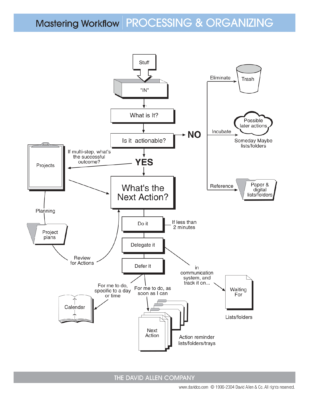Having a System for Life

The reason for writing this is that I recently went to visit my mother. The visit really made me reflect on how important it is to have a system for life. What I mean by that is having a system for organization and productivity. My mother is so disorganized that clutter has began to fill her home. Bills weren’t getting paid on time, she has numerous subscriptions that are completely unnecessary, and she has so much stuff that she feels overwhelmed. This disorganization has cost her so much money and time.
This waste could be completely solved if there was a system for life in place. Now, I was never as bad as she’s gotten, but I had some issues of my own. Until I read the book “Getting Things Done” by David Allen I had some serious disorganization problems. Getting Things Done (GTD) is not only a book, but also a system for getting organized. I can honestly say it changed my life in a very positive way.
The Five Pillars of GTD
The great thing about GTD is it doesn’t put rules around how you actually do your work. Instead, it focuses on how you capture the work you need to do, organize it, and choose what needs your attention. At its core, GTD stands on five “pillars,” or steps to getting and staying organized:
Capture
Capture everything. Your to-dos, your ideas, your recurring tasks, everything. Put it in a pen-and-paper notebook, a to-do app, a planner, whatever you prefer to use to get organized. GTD doesn’t say to use a specific tool, but whatever you use has to fit into your normal flow. The barrier to using it should be so low that there’s never a reason for you to say “I’ll add it to my list later.” You want to capture everything as soon as it happens so you don’t have to think about it again until it’s time to do it.
Clarify
Organize
Reflect
Engage
Those are the basic principles of GTD. At its core, GTD gives you a way to get everything you need to remember out of your head and into a system that can remember them for you, organize them, and break them down into pieces you can work with. That way the next time you look at your to-do list, there should be no confusion over what you have time to tackle, or what’s most important. You can spend less time thinking about what to do and how to work and more time actually working.
Below is the graphic describing the process you should take for all information that comes to you.

Listen to the Audio Below!
Podcast: Play in new window | Download
